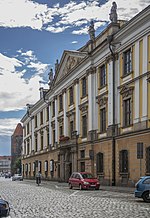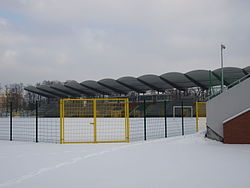Legnica (Polish: [lɛɡˈɲit͡sa] ; German: Liegnitz, pronounced [ˈliːɡnɪts]; Silesian: Ligńica; Czech: Lehnice; Latin: Lignitium) is a city in southwestern Poland, in the central part of Lower Silesia, on the Kaczawa River and the Czarna Woda. It is the seat of the county and since 1992 the city has been the seat of a Diocese. As of 2023, Legnica had a population of 97,300 inhabitants.The city was first referenced in chronicles dating from the year 1004, although previous settlements could be traced back to the 7th century. The name "Legnica" was mentioned in 1149 under High Duke of Poland Bolesław IV the Curly. Legnica was most likely the seat of Bolesław and it became the residence of the dukes of Legnica from 1248 until 1675. Legnica is a city over which the Piast dynasty reigned the longest, for about 700 years, from the time of ruler Mieszko I of Poland after the creation of the Polish state in the 10th century, until 1675 and the death of the last Piast duke George William. Legnica is one of the historical burial sites of Polish monarchs and consorts.
Legnica became renowned for the fierce battle that took place at Legnickie Pole near the city on 9 April 1241 during the first Mongol invasion of Poland, which ended in the defeat of the Polish-led Christian coalition by the Mongols.
Legnica is an economic, cultural and academic centre in Lower Silesia, together with Wrocław. The city is renowned for its varied architecture, spanning from early medieval to modern period, and its preserved Old Town with the Piast Castle, one of the largest in Poland. According to the Foreign direct investment ranking (FDI) from 2016, Legnica is one of the most progressive high-income cities in the Silesian region.












